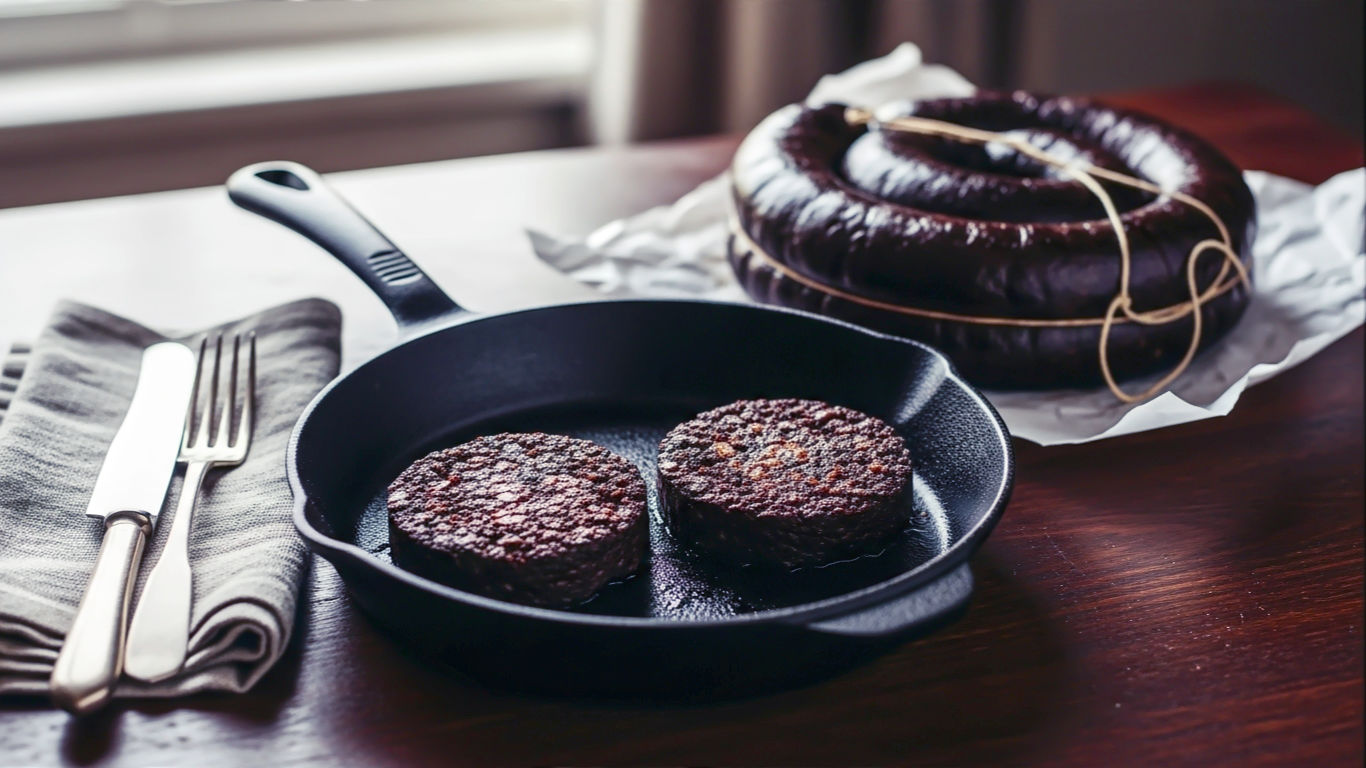Black Pudding Bounty: Exploring Bury’s Signature Savoury
Explore the definitive guide to Bury black pudding. From its ancient origins to modern recipes and the fight to protect its name, this is its story.

This post may contain affiliate links. If you make a purchase through these links, we may earn a commission at no additional cost to you.
It’s a dark, crumbly disc of comfort, a staple of the full English breakfast, and a food that often divides opinion right down the middle. For some, it’s an essential, richly savoury part of a proper fry-up. For others, the very idea of what it’s made from is enough to make them politely push their plate away. We’re talking, of course, about black pudding. And while you can find versions of it across the globe, one town in the north of England has made this humble blood sausage its own.
Welcome to Bury, a proud market town nestled in Greater Manchester. For centuries, this has been the undisputed capital of black pudding. It’s a place where recipes are guarded more fiercely than state secrets, where family butchers have become local legends, and where the air on market day carries the faint, peppery scent of its most famous export.
But how did a simple sausage, born from the thrifty need to use every part of an animal, become a celebrated delicacy? What makes a Bury black pudding so special that people will travel miles just to buy a length of it? And how did it lead to an annual contest where grown adults hurl puddings at a pile of Yorkshire Puddings stacked on a scaffold?
This is the story of Bury black pudding – a tale of history, tradition, and culinary pride. It’s a journey that takes us from ancient campfires to modern gastropubs, from local market stalls to the ongoing battle to protect a northern icon. So, grab a brew, pull up a chair, and let’s explore the rich, dark, and utterly delicious world of Bury’s signature savoury.
What on Earth Is Black Pudding? A Plain English Guide
Before we dive into what makes Bury’s version the king, let’s get the basics sorted. What exactly is black pudding?
At its heart, black pudding is a type of blood sausage. It sounds a bit dramatic, but it’s a tradition found in countless cultures around the world, from Spain’s morcilla to France’s boudin noir. The principle is simple and comes from a time before supermarkets and shrink-wrapped meat: when you slaughtered an animal, you wasted nothing. Absolutely nothing.
The core ingredients are straightforward:
- Blood: Traditionally, this was pig’s blood. It’s what gives the pudding its distinctive dark, almost black, colour and its rich, savoury, slightly metallic tang.
- Fat: Usually suet (the hard fat from around the kidneys) or pork fat. This is crucial for giving the pudding its moist, crumbly texture. Without it, it would be dry and dense.
- Cereal: This is the ‘filler’ or ‘binder’ that bulks out the sausage and soaks up the flavour. In Britain, this is almost always pearl barley or oats. The type of cereal used is one of the key things that distinguishes different regional puddings.
- Herbs and Spices: This is where the magic happens and where recipes become closely guarded secrets. A classic Bury black pudding will have a subtle but distinct peppery warmth. Common seasonings include pepper, mace, coriander, and a mix of secret herbs.
- Onions: Sometimes added for extra flavour and texture.
All these ingredients are mixed together, packed into a natural or synthetic casing to form a long sausage, and then boiled or simmered until cooked through. It’s then ready to be sliced, fried, and enjoyed. Think of it less as a gory experiment and more as a rustic, savoury, oaty sausage that just happens to have a very dark colour. When cooked, it becomes beautifully crisp on the outside and soft and crumbly on the inside – a perfect partner for bacon, eggs, and a dollop of brown sauce.
A Journey Through Time: The Long and Bloody History of Black Pudding
The idea of making food from blood isn’t a new one. In fact, it’s one of the oldest forms of sausage-making in the world. The earliest known mention of a blood sausage pops up in Homer’s epic Greek poem, The Odyssey, written around the 8th century BC. In it, he describes men fighting for “a stomach full of fat and blood” as a prize. It seems even the ancient Greeks appreciated a good pudding.
The Romans were also fans. Their version, known as botellus, was a popular dish among legionaries. As the Roman Empire expanded, they brought their customs and their cooking with them. It’s widely believed that the Romans introduced the first blood sausages to Britain, a thrifty and portable food perfect for feeding a marching army.
For centuries, the black pudding remained a humble farmhouse food across the country. It was known as a ‘pudding’ because, like haggis or steak and kidney pudding, it was boiled in a casing or cloth during cooking. Every region developed its own style. In Scotland, they have the Stornoway Black Pudding, a protected food that uses oatmeal for a rougher texture. The Midlands and the West Country also have their own distinct traditions.
So, how did Bury become the centre of the black pudding universe?
Why Bury? The Making of a Northern Delicacy
The story of Bury’s rise to pudding pre-eminence is tied to the Industrial Revolution. As towns like Bury grew into bustling centres of the textile industry, they needed feeding. Workers pouring into the mills and factories required cheap, hearty, and nutritious food. Black pudding fitted the bill perfectly.
Butchers in the area, many of whom were also farmers, found themselves with a ready supply of ingredients and a hungry market. They refined their recipes, creating a smoother, more refined pudding than the rustic farmhouse versions. They used pearl barley, which gave it a softer texture than the oats used elsewhere, and developed their own unique spice blends.
The town’s famous market, granted a charter back in the 1440s, became the perfect place to sell it. Stalls piled high with coils of black pudding became a common sight. The pudding’s reputation began to spread, carried by word of mouth from people who had tasted the unique flavour and quality of the Bury variety. It wasn’t just a food; it was a symbol of Northern thrift, ingenuity, and flavour.
A wave of immigration in the 19th century also played a part. A German butcher named Caspar Metcalfe is often credited with bringing his continental sausage-making skills to the town, helping to further refine the local product. Families started to specialise, and soon, names like Chadwick, Haffner, and Kay’s became synonymous with the best black pudding money could buy.
The Anatomy of a Bury Black Pudding: What’s Inside?
So, what is it that sets a true Bury black pudding apart from the rest? While the exact recipes are a guarded secret, the defining characteristics come down to a few key elements.
The Cereal: Pearl Barley is King
Unlike its Scottish cousin from Stornoway, which uses oatmeal, the traditional Bury black pudding is made with pearl barley. The barley grains are cooked until they are soft and plump. This gives the final pudding a much smoother and softer texture. When you slice into a Bury pudding, you shouldn’t find large, coarse grains of oat. Instead, the texture is more uniform and crumbly.
The Fat: A Richer, Moister Pudding
Bury black pudding traditionally uses high-quality pork fat rather than beef suet. The fat is diced into small, neat cubes. During the cooking process, these little pockets of fat melt and distribute themselves through the pudding, ensuring it stays moist and rich. This is why a good Bury pudding doesn’t taste dry. When you fry it, this fat helps the outside to crisp up beautifully while the inside stays soft.
The Spice Blend: A Secret, Peppery Warmth
This is the most mysterious part of the recipe. Every maker has their own secret blend of herbs and spices, passed down through generations. However, the signature flavour profile of a Bury pudding is a gentle, warming spice. Pennyroyal, a herb from the mint family, was historically a key ingredient, though it’s used less frequently today due to health concerns in large quantities. The dominant flavours you’ll taste are usually black pepper, mace, coriander, and pimento (allspice). The seasoning is subtle – it shouldn’t be fiery or overpowering. It’s a gentle warmth that complements the rich, earthy flavour of the pudding.
The Cooking Process: It’s All in the Simmer
Once the mixture of fresh blood, cooked barley, fat, and spices is combined, it’s piped into casings. These are then carefully coiled and gently simmered in large coppers for several hours. This slow cooking process is vital. It allows the flavours to meld together and ensures the pudding is cooked through evenly without the casing splitting. After cooking, the puddings are hung up to cool and dry, developing their firm texture and classic dark sheen.
Meet the Makers: The Guardians of Bury’s Black Pudding Legacy
You can’t talk about Bury black pudding without talking about the people who make it. For generations, a handful of family-run businesses have been the custodians of the town’s most famous product. These aren’t huge, faceless corporations; they are local butchers who have built their reputations on quality and tradition.
The Famous Four
For decades, the market was dominated by four legendary names, each with a stall on Bury’s world-famous market:
- Chadwicks Original: Often considered one of the originals, their recipe dates back generations. Their stall has been a fixture on the market for as long as anyone can remember.
- The Bury Black Pudding Company: Perhaps the most famous name today, this company has taken the local delicacy global. Starting from a market stall, they now supply major supermarkets across the UK and even export their puddings. They’ve managed to scale up production while sticking to a traditional recipe, winning countless awards along the way.
- Walsh’s: Another long-standing family of pudding makers, Walsh’s are known for their traditional, richly flavoured puddings.
- Kay’s/Cass Kay’s: A name deeply woven into the fabric of Bury Market, Cass Kay’s puddings were legendary, known for their distinct flavour and quality.
These makers are the heart and soul of the industry. Their friendly rivalries and dedication to their craft have kept the standards incredibly high. Visiting Bury Market and seeing their stalls, piled high with fresh puddings, is a truly authentic foodie experience.
More Than Just Breakfast: How to Eat Black Pudding Like a Pro
For most people in Britain, black pudding means one thing: breakfast. Sliced thick and fried until crispy, it’s the perfect companion to a runny-yolked egg, a sizzling sausage, and a slice of bacon. There’s no denying it’s a classic for a reason.
But to limit black pudding to the breakfast plate is to do it a great disservice. Its rich, savoury, and crumbly texture makes it an incredibly versatile ingredient. Top chefs and home cooks alike have rediscovered its potential.
Here are a few ways to enjoy it beyond the fry-up:
- With Scallops: This is a modern restaurant classic. The sweet, delicate flavour of seared scallops is a perfect match for the salty, earthy black pudding. Often served with a pea purée, it’s a simple but seriously impressive starter.
- Crumbled Over Salads: Forget croutons. Try crumbling fried black pudding over a warm salad. It works especially well with ingredients like bacon, poached eggs, and a sharp vinaigrette dressing.
- In a Scotch Egg: A truly magnificent invention. A soft-boiled egg is wrapped in a mix of sausage meat and black pudding, then coated in breadcrumbs and deep-fried. The result is a savoury, crunchy, gooey masterpiece.
- Stuffed into Chicken or Pork: Mix crumbled black pudding with breadcrumbs, herbs, and apple, and use it to stuff a chicken breast or a pork loin before roasting. It keeps the meat moist and adds a massive punch of flavour.
- On a Pizza: Yes, really. Crumbled black pudding with goat’s cheese and red onion makes for a delicious, savoury pizza topping.
The key is to think of it as a powerful seasoning as well as a main ingredient. A little bit goes a long way to adding depth and savouriness to a dish.
The World Black Pudding Throwing Championships: A Curious Tradition
If you needed any more proof of how seriously this part of the world takes its puddings, look no further than the annual World Black Pudding Throwing Championships. Held every September in the nearby town of Ramsbottom, this quirky event draws crowds from all over.
The concept is wonderfully simple. Contestants are given three black puddings and tasked with throwing them underarm to knock as many Yorkshire puddings as possible off a 20-foot-high scaffold.
The tradition supposedly dates back to the Wars of the Roses, the historic rivalry between the houses of Lancaster and York. Legend has it that during one battle in the area, the opposing armies ran out of ammunition and resorted to flinging food at each other. The Lancastrians threw their black puddings, and the Yorkshiremen retaliated with their Yorkshire puddings.
It’s a fantastic, eccentric, and very northern day out, celebrating a historic rivalry with a healthy dose of silliness and, of course, a deep appreciation for local food.
Is It Good for You? Unpacking the Nutritional Debate
For years, black pudding was seen as a guilty pleasure – a fatty, indulgent part of a fry-up. When the ‘superfood’ craze hit its peak in the mid-2010s, some newspapers dramatically declared that black pudding was the next big thing, hailing it as a miracle food packed with iron and protein.
So, what’s the truth? As with most things, it’s somewhere in the middle.
The Good Bits:
- Rich in Iron: Because its main ingredient is blood, black pudding is an excellent source of iron. This is the type of iron (heme iron) that is easily absorbed by the body. It’s great for preventing anaemia and boosting energy levels.
- High in Protein: It’s also packed with protein, which is essential for building muscle and keeping you feeling full.
- Source of Zinc and Potassium: It provides useful amounts of other minerals like zinc, which is good for the immune system.
The Not-So-Good Bits:
- High in Salt: Like most processed meats, black pudding can be very high in sodium (salt). Too much salt is linked to high blood pressure.
- High in Fat: While the fat is crucial for its texture and taste, it does mean black pudding is high in calories and saturated fat.
- It’s Processed Meat: The World Health Organisation has classified processed meats as a Group 1 carcinogen, meaning there is strong evidence that they can cause cancer, particularly bowel cancer. This doesn’t mean you can never eat it, but official advice suggests limiting your intake.
The verdict? Black pudding isn’t a ‘superfood’, but it’s not a nutritional villain either. Eaten in moderation as part of a balanced diet, it can be a good source of important minerals. It’s best viewed as a treat – a delicious, satisfying, and traditional food to be enjoyed, but perhaps not every single day.
The Fight for the Name: The Quest for PGI Status
In the world of food, a name can mean everything. Just as you can only call sparkling wine ‘Champagne’ if it comes from the Champagne region of France, many producers believe ‘Bury Black Pudding’ should be a protected name.
This protection comes in the form of a Protected Geographical Indication (PGI). It’s a legal status awarded by the EU (and now managed by the UK government) that ensures a product has a specific quality or reputation linked to the area it’s made in. The Cornish Pasty and the Stornoway Black Pudding already have this status.
For years, Bury’s producers have been campaigning for the same protection. They argue that the name ‘Bury Black Pudding’ is a guarantee of quality, linked to the specific ingredients (like pearl barley) and methods used in the town. Without PGI status, anyone, anywhere, can make a product, call it a ‘Bury-style’ black pudding, and sell it – even if it doesn’t meet the traditional standards.
The campaign has been complex and hasn’t yet succeeded. Disagreements between producers on the exact recipe that should be protected have been one of the hurdles. But the fight continues, driven by a desire to protect the town’s heritage and ensure that when a customer buys a Bury black pudding, they are getting the genuine article.
The Future of Black Pudding: From Humble Breakfast Staple to Gourmet Star
What does the future hold for this northern delicacy? Far from fading away, the Bury black pudding is enjoying something of a renaissance. Its journey from a thrifty farmhouse food to a celebrated gourmet ingredient is complete.
You’ll now find it on the menus of Michelin-starred restaurants, celebrated by the world’s best chefs for its unique flavour and texture. Food festivals and farmers’ markets proudly showcase artisanal versions. At the same time, it remains a comforting and affordable staple, still served with pride in greasy spoon cafés and on family breakfast tables up and down the country.
It has proven itself to be remarkably adaptable. It’s a food that feels both historic and modern, both humble and sophisticated. It represents the best of British food culture: a deep respect for tradition, a commitment to quality ingredients, and a no-nonsense approach to flavour.
A Taste of Bury’s Enduring Gift
The story of the Bury black pudding is the story of the town itself. It’s a story of resilience, pride, and the quiet determination to make something truly excellent from simple ingredients. It’s a food that has nourished generations, fuelled a local economy, and put a small northern town on the global culinary map.
Whether it’s your favourite part of a fry-up or a curious delicacy you’ve yet to try, there’s no denying its place in the heart of British cuisine. It’s more than just a sausage; it’s a slice of history. And it’s a taste that, once you’ve acquired it, you’ll never forget. Long live the Bury black pudding.
Further Reading
- The Bury Black Pudding Company: Explore the story of one of Bury’s most famous producers and browse their products. https://www.buryblackpuddings.co.uk/
- Bury Market: Discover the history and find details of the market traders, including the famous pudding stalls. https://www.burymarket.com/
- World Black Pudding Throwing Championships: Find out more about this wonderfully eccentric event. https://www.facebook.com/worldblackpuddingthrowingchampionship/






